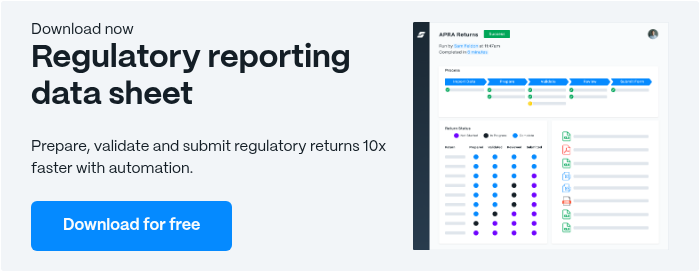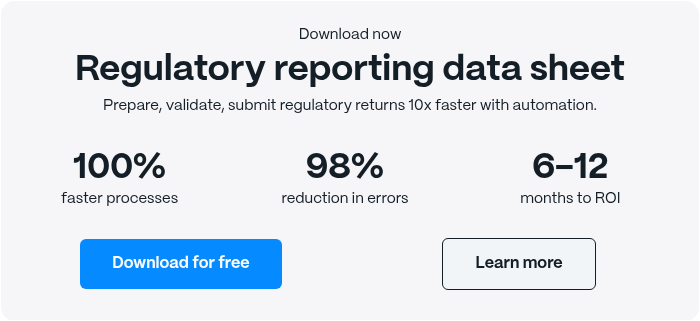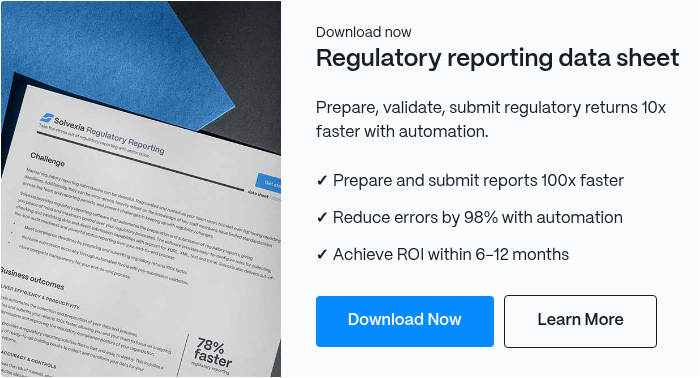Compliance Reporting: Definition, Types & Examples

Noncompliance can be catastrophic. Organizations that fail to meet regulatory requirements face substantial fines, legal disputes, reputational damage, and potential closure.
Compliance reporting is the process organizations use to demonstrate adherence to regulatory requirements, industry standards, and internal controls. For most businesses, regulatory compliance reporting is a recurring obligation that demands precision and accuracy. Manual processes are time-consuming and error-prone, which is why many organizations are adopting automated compliance reporting solutions.
This guide covers everything you need to know about compliance reporting—types of reports, best practices, and how compliance reporting automation can transform your compliance function.
Coming Up
1. What is Compliance Reporting?
2. Types of Compliance Reports
3. Who Compiles and Reads Compliance Reports?
4. The Compliance Reporting Process: Step-by-Step Guide
5. Examples of Compliance Reports
6. Key Benefits of Compliance Reporting
7. Common Challenges in Compliance Reporting
8. Automating Compliance Reporting with Software Solutions
9. Best Practices for Effective Compliance Reporting in 2026
What is Compliance Reporting?
Compliance reporting is the process of collecting, verifying, and documenting evidence that demonstrates an organization’s adherence to regulatory requirements, industry standards, and internal policies. A compliance report provides tangible proof that your company is following applicable laws and regulations within the relevant regulatory framework that shapes these requirements. Compliance reporting helps organizations meet their compliance obligations by ensuring that all necessary documentation and evidence are maintained and available for review.
The compliance reporting process involves:
- Following a defined compliance process, which is a structured set of procedures for ensuring regulatory adherence
- Gathering data on how information is collected, controlled, stored, and shared
- Documenting policies, procedures, and internal controls
- Verifying accuracy and completeness of compliance-related information
- Compiling findings into structured reports for review
Who uses compliance reports?
Internal stakeholders including management teams, executives, board members, compliance officers, and other relevant stakeholders rely on these reports to monitor adherence to regulations. External audiences such as regulatory bodies, auditors, and investors review compliance reports to assess organizational risk and governance practices.
Why automation matters
As data volumes grow and regulations evolve, manual compliance reporting becomes unsustainable. Compliance reporting solutions automate data collection, reduce human error, and enable teams to focus on strategic initiatives rather than manual report compilation. Automated compliance reporting also ensures consistency, improves accuracy, and makes it easier to respond quickly to regulatory changes.
Types of Compliance Reports
Compliance reports vary based on industry, regulatory requirements, and organizational needs. Understanding the different types helps ensure you’re meeting all applicable standards.
Many organizations require multiple types of compliance reports to meet all applicable regulations. Each report should be tailored to the specific regulations applicable to the organization’s industry and operations, ensuring that compliance documentation aligns with the exact laws, standards, and guidelines that must be followed.
Here are the five main categories:
Regulatory Compliance Reports
Regulatory reports demonstrate adherence to laws and regulations imposed by government agencies and industry bodies, as well as alignment with relevant regulatory frameworks. These reports are typically required by external regulatory authorities and vary by industry and location.
Examples include:
- Anti-Money Laundering (AML) reports for financial institutions
- Environmental compliance reports for manufacturing
- Safety compliance reports for healthcare facilities
- Industry-specific regulatory filings
Financial Compliance Reports
Financial compliance reports ensure an organization’s financial practices meet accounting standards and regulatory requirements. These reports help organizations comply with financial regulations such as SOX by providing transparency into financial health and internal control effectiveness.
Examples include:
- SOX (Sarbanes-Oxley) compliance reports for public companies
- GAAP compliance documentation
- Tax compliance reports
- Audit findings and financial statement certifications
IT Compliance Reports
IT compliance reports focus on cybersecurity, data protection, and technology governance. These reports demonstrate that information systems meet security standards and protect sensitive data from breaches and unauthorized access.
Examples include:
- SOC 2 compliance reports
- ISO 27001 certification documentation
- PCI DSS compliance reports for payment processing
- Penetration testing and vulnerability assessment reports
Operational Compliance Reports
Operational reports document adherence to internal policies, quality standards, and operational procedures. These are often used internally to optimize processes and ensure consistency across the organization.
Examples include:
- Quality management system audits
- Supply chain compliance documentation
- Health and safety compliance reports
- Standard operating procedure (SOP) compliance reviews
Data Privacy Compliance Reports
Data privacy reports demonstrate commitment to protecting personal and sensitive information in accordance with data protection laws. These reports are increasingly critical as privacy regulations expand globally.
Examples include:
- GDPR compliance documentation for EU data protection
- HIPAA compliance reports for healthcare organizations
- CCPA compliance reports for California consumer privacy
- Data breach response and notification reports
Which reports does your organization need?
The answer depends on your industry, geographic location, data handling practices, and whether you're publicly traded. Many organizations require multiple types of compliance reports to meet all applicable regulations.
Who Compiles and Reads Compliance Reports?
Who creates them?
In large organizations, a Chief Compliance Officer (CCO) typically owns compliance reporting, establishing the standards and policies the organization must follow. Smaller organizations often assign this responsibility to IT professionals, legal staff, finance managers, or risk personnel. Regardless of company size, the person handling regulatory compliance reporting should have deep knowledge of industry regulations and organizational processes.
Compliance reporting solutions reduce dependency on individual expertise by automating data collection and providing consistent structure—making it easier to identify noncompliant activities across the organization. Automation also helps streamline compliance processes, making it easier to evaluate their effectiveness and improve overall compliance efforts.
Who reads them?
Compliance reports serve both internal and external audiences. Internally, board members, executives, department heads, and compliance officers use these reports to monitor adherence and improve processes. Externally, regulatory agencies, auditors, investors, and certification bodies review compliance reports to assess organizational risk and governance.
External reports carry high stakes—evidence of noncompliance can result in fines, sanctions, or penalties. However, reports demonstrating good faith efforts may prompt regulatory bodies to assist with remediation rather than impose punitive measures. Transparent compliance reporting also strengthens investor confidence by demonstrating the organization’s commitment to regulatory adherence.
The Compliance Reporting Process: Step-by-Step Guide
Creating effective compliance reports requires a systematic approach. Compliance reporting is an ongoing process that requires continuous attention and adaptation. Follow these steps to ensure accurate, timely regulatory compliance reporting:
1. Understand reporting requirements
Identify which regulations apply to your organization and what evidence you need to demonstrate compliance. It is essential to have a comprehensive understanding of regulatory requirements and data collection processes to ensure your compliance reports are accurate and complete. Define the scope, objectives, and audience for each report. Review requirements from regulatory bodies to ensure you capture all necessary information.
2. Assign roles and responsibilities
Designate a report owner and identify all stakeholders who need to contribute data. Ensure everyone understands their role in the compliance reporting process and establish clear accountability.
3. Collect and organize data
Gather relevant information from across the organization—policy documents, audit findings, risk assessments, incident reports, and control testing results. Use compliance reporting automation to centralize data collection and reduce manual errors.
4. Verify data accuracy
Cross-check information from multiple sources to ensure completeness and reliability. Implement validation processes to catch discrepancies before report compilation. Inaccurate data can lead to noncompliance findings and penalties.
5. Analyze findings
Evaluate the data against regulatory benchmarks and internal standards. Identify compliance gaps, areas of risk, and trends that require attention. This analysis forms the foundation of your report’s insights. Detailed analysis provides valuable insights for decision-making and continuous improvement.
6. Compile the report
Structure your compliance report to include: executive summary, scope and objectives, compliance status, risk assessment, findings, and recommended actions. The final report should comprehensively summarize findings and evidence, ensuring it meets the needs of stakeholder communication and regulatory purposes. Support claims with documented evidence and make the report clear enough for non-technical audiences to understand.
7. Review and approve
Have key stakeholders review the draft report for accuracy and completeness. Obtain necessary sign-offs from executives or the CCO before submission to external parties.
8. Submit and track
Deliver the report to the appropriate regulatory bodies or internal stakeholders by the required deadline. Maintain records of all submissions for audit trails and future reference.
9. Monitor and update
Compliance reporting isn’t a one-time event. Regular monitoring and updates are essential for maintaining compliance over time. Track implementation of recommended actions, monitor for regulatory changes, and continuously update your reporting processes to reflect evolving requirements.
Pro tip: Automated compliance reporting solutions can streamline steps 3-6, dramatically reducing the time required to produce accurate reports while minimizing human error.
Examples of Compliance Reports
Compliance report content and structure vary based on regulatory requirements and intended audience. Regulatory-mandated reports follow prescribed formats, while internal compliance reports can be customized to organizational needs.
Here are common examples of compliance reports across industries:
- GDPR Compliance Reports: Document data protection measures for EU citizen data, including legal basis for data processing, individual rights management, data transfer protocols, and breach notification procedures.
- HIPAA Compliance Reports: Demonstrate safeguards protecting patient health information (PHI), covering administrative, technical, and physical security controls, privacy policies, and breach management.
- SOX Compliance Reports: Required for publicly traded companies, these reports verify the accuracy of financial statements and document internal controls designed to prevent fraud and ensure financial integrity.
- PCI DSS Compliance Reports: Prove adherence to Payment Card Industry Data Security Standards, detailing security controls for cardholder data protection including firewalls, encryption, and access controls.
- SOC 2 Reports: Developed by the American Institute of CPAs (AICPA), these reports verify that service organizations have appropriate controls related to security, availability, processing integrity, confidentiality, and privacy.
- ISO Compliance Reports: Document adherence to International Organization for Standardization standards—commonly ISO 27001 for information security management or ISO 9001 for quality management.
- Know Your Customer (KYC) Compliance Reports: Detail customer identity verification processes, risk assessments, and ongoing monitoring procedures required in financial services.
Most industries require multiple compliance reports to address different regulatory obligations. As data protection regulations expand globally, compliance reporting examples continue to grow—particularly around privacy and cybersecurity standards.
Key Benefits of Compliance Reporting
Regulatory compliance reporting delivers strategic value that extends far beyond simply meeting legal obligations. Achieving compliance excellence should be a key objective for organizations seeking to maximize the benefits of compliance reporting. Here are the key benefits:
Builds stakeholder trust and credibility
Organizations that demonstrate compliance through transparent reporting earn trust from customers, investors, and business partners. Compliance reports provide concrete evidence that you're protecting sensitive data, following ethical practices, and operating with integrity. This credibility becomes a competitive advantage when stakeholders evaluate potential business relationships.
Strengthens risk management
Regular compliance reporting helps identify vulnerabilities before they escalate into costly problems. These reports play a critical role in identifying, analyzing, and prioritizing compliance risks, ensuring that organizations address potential threats to regulatory adherence effectively. By documenting controls, monitoring processes, and tracking incidents, organizations gain visibility into risk areas and can take proactive corrective action. This early detection prevents fines, legal disputes, and operational disruptions.
Increases transparency and accountability
Compliance reports create a clear record of who is responsible for what, how decisions are made, and where improvements are needed. This transparency improves internal governance and gives leadership the insights needed to make informed strategic decisions. It also demonstrates to regulators that your organization takes compliance seriously. Tracking key performance indicators helps measure the effectiveness of compliance activities and reporting processes, ensuring ongoing transparency and accountability.
Reduces operational inefficiencies
The compliance reporting process often reveals redundancies, bottlenecks, and outdated procedures. Addressing these issues through compliance reporting directly contributes to improved operational efficiency. Organizations can streamline operations, eliminate waste, and improve overall performance by addressing these issues. Automated compliance reporting solutions amplify this benefit by reducing manual effort and human error.
Protects against financial and reputational damage
Noncompliance can result in substantial fines, lawsuits, loss of licenses, and lasting reputational harm. Consistent compliance reporting mitigates these risks by ensuring your organization stays ahead of regulatory requirements and maintains documentation that proves due diligence.
Common Challenges in Compliance Reporting
Organizations face several obstacles when implementing effective compliance reporting programs. Understanding these challenges helps you address them proactively. Organizations must also be prepared for regulatory scrutiny, which increases the importance of accurate and timely compliance reporting.
Data collection and accuracy issues
Gathering compliance data from disparate systems, departments, and sources creates complexity. Manual data entry introduces errors, while data silos make it difficult to get a complete picture. Inconsistent data formats and missing information can compromise report accuracy—a critical issue when regulatory bodies review your submissions. Compliance reporting solutions that centralize data collection help overcome these obstacles.
Keeping pace with regulatory changes
Regulations evolve constantly, and tracking changes across multiple jurisdictions and standards is resource-intensive. Organizations must adapt their compliance strategies to keep pace with evolving regulatory landscapes. New requirements for data privacy, financial reporting, and industry-specific rules emerge regularly. Organizations struggle to update their compliance reporting processes quickly enough to maintain adherence. Missing a regulatory change can result in unintentional noncompliance and penalties.
Resource constraints
Compliance reporting demands significant time, expertise, and budget. Smaller organizations often lack dedicated compliance personnel, forcing teams to juggle compliance work alongside other responsibilities. Even large organizations face resource limitations when managing multiple compliance frameworks simultaneously. Manual compliance reporting processes consume hours that could be spent on strategic initiatives.
Complexity and interpretation
Understanding exactly what regulators require isn't always straightforward. Vague regulatory language, conflicting guidance, and evolving interpretations create confusion about what to report and how to format it. Organizations may over-report to be safe, wasting resources, or under-report and risk noncompliance.
Technology gaps
Legacy systems and spreadsheet-based processes can't scale with growing compliance demands. Without automated compliance reporting tools, teams struggle with version control, audit trails, and timely report generation. Technology gaps also make it difficult to demonstrate continuous compliance rather than point-in-time assessments.
Automating Compliance Reporting with Software Solutions
Manual compliance reporting is time-consuming, error-prone, and difficult to scale. As regulatory requirements grow more complex, organizations are turning to automated compliance reporting to improve accuracy, reduce costs, and free up resources for strategic work.
How compliance reporting automation works
Compliance reporting solutions, such as Solvexia, automate the entire reporting lifecycle—from data collection and validation to report generation and submission. These platforms integrate with existing systems (ERP, CRM, databases) to pull data automatically, eliminating manual entry. Built-in validation rules catch errors before reports are finalized, while centralized dashboards provide real-time visibility into compliance status.
Key benefits of automated compliance reporting
- Faster report generation: What once took days or weeks can be completed in hours. Automated systems compile data, run analytics, and produce formatted reports without manual intervention.
- Improved accuracy: Automation eliminates human error in data entry, calculations, and formatting. Consistent processes ensure every report meets quality standards.
- Continuous compliance monitoring: Rather than point-in-time snapshots, automated systems track compliance continuously. You'll identify issues immediately instead of discovering them during audits.
- Audit trail and documentation: Software solutions automatically maintain complete records of who did what and when, creating the audit trails regulators require.
- Scalability: As your organization grows or takes on new compliance requirements, automation scales effortlessly without adding headcount.
- Reduced compliance costs: By minimizing manual effort and preventing noncompliance penalties, automation delivers significant ROI.
What to look for in compliance reporting software
Choose solutions that integrate with your existing technology stack, support multiple compliance frameworks, provide customizable reporting templates, and offer robust security controls. The right platform should reduce complexity, not add to it.
Organizations that implement compliance reporting automation report dramatic improvements in efficiency, accuracy, and team satisfaction. Compliance teams shift from data gathering to strategic analysis, while executives gain confidence that nothing falls through the cracks.
Best Practices for Effective Compliance Reporting in 2026
Regulatory landscapes continue evolving rapidly. Organizations that adopt these best practices will stay ahead of compliance requirements while maximizing efficiency.
- Embrace automation and AI: Manual compliance reporting can’t keep pace with modern regulatory demands. Implement automated compliance reporting solutions that use AI to flag anomalies, predict risks, and streamline data collection. Machine learning can identify patterns that humans miss, improving both accuracy and speed.
- Adopt continuous compliance monitoring: Move beyond periodic audits to real-time compliance tracking. Continuous monitoring enables immediate detection of issues, faster remediation, and better risk management. This approach also reduces the stress of audit season by maintaining audit-readiness year-round.
- Centralize compliance data: Break down data silos by creating a single source of truth for all compliance information. Centralized data improves accuracy, simplifies reporting across multiple frameworks, and provides leadership with comprehensive compliance visibility.
- Stay current with regulatory changes: Subscribe to regulatory updates, join industry associations, and leverage compliance reporting software that automatically incorporates new requirements. Assign someone to monitor changes affecting your industry and geography, then update processes accordingly.
- Integrate ESG and non-financial metrics: Stakeholders increasingly expect reporting on environmental, social, and governance (ESG) factors alongside traditional compliance metrics. Organizations that proactively incorporate ESG into their compliance reporting demonstrate forward-thinking leadership and meet growing investor demands. Aligning compliance activities with the organization’s strategic objectives enhances the effectiveness and cohesion of compliance efforts.
- Standardize reporting processes: Document clear procedures for data collection, validation, review, and approval. Standardization reduces errors, eliminates key person dependencies, and ensures consistent quality regardless of who creates the report. Clearly defined compliance measures help organizations meet industry-specific data security and regulatory requirements.
- Invest in compliance training: Ensure everyone involved in regulatory compliance reporting understands their responsibilities, relevant regulations, and your organization’s policies. Regular training reduces errors and builds a culture of compliance awareness. Fostering a strong compliance culture is essential for embedding compliance into daily operations and promoting proactive engagement.
- Conduct regular internal audits: Don’t wait for external audits to identify gaps. Regular internal reviews help catch issues early, validate control effectiveness, and demonstrate due diligence to regulators.
- Leverage dashboards and visualization: Transform compliance data into visual dashboards that make it easy for executives and board members to understand compliance status at a glance. Visual reporting improves decision-making and stakeholder communication.
- Prepare for AI regulation: As organizations adopt AI tools, new regulations around algorithmic transparency, bias, and data usage are emerging. Start documenting AI usage, decision-making processes, and risk assessments now to stay ahead of forthcoming compliance requirements.
Final Thoughts
Whether mandated by regulators or adopted proactively, compliance reporting is essential for protecting your organization from legal, financial, and reputational risks. Regular, consistent reporting demonstrates accountability, builds stakeholder trust, and helps identify vulnerabilities before they become costly problems.
The complexity of modern regulatory requirements makes manual processes unsustainable. Automated compliance reporting solutions transform compliance from a burden into a strategic advantage—delivering accuracy, efficiency, and real-time visibility that manual methods simply can't match.
Organizations that invest in compliance reporting automation today position themselves for long-term success in an increasingly regulated business environment.
FAQ
Intelligent reconciliation solution
Intelligent rebate management solution
Intelligent financial automation solution
Intelligent Financial Automation Solution
Intelligent financial automation solution
Intelligent financial automation solution
Intelligent financial automation solution
Intelligent financial automation solution
Intelligent regulatory reporting solution
Free up time and reduce errors
Recommended for you

Request a Demo
Book a 30-minute call to see how our intelligent software can give you more insights and control over your data and reporting.

Reconciliation Data Sheet
Download our data sheet to learn how to automate your reconciliations for increased accuracy, speed and control.

Regulatory Reporting Data Sheet
Download our data sheet to learn how you can prepare, validate and submit regulatory returns 10x faster with automation.

Financial Automation Data Sheet
Download our data sheet to learn how you can run your processes up to 100x faster and with 98% fewer errors.

Financial Automation Data Sheet
Download our data sheet to learn how you can run your processes up to 100x faster and with 98% fewer errors.

Financial Automation Data Sheet
Download our data sheet to learn how you can run your processes up to 100x faster and with 98% fewer errors.

Financial Automation Data Sheet
Download our data sheet to learn how you can run your processes up to 100x faster and with 98% fewer errors.

Financial Automation Data Sheet
Download our data sheet to learn how you can run your processes up to 100x faster and with 98% fewer errors.

Financial Automation Data Sheet
Download our data sheet to learn how you can run your processes up to 100x faster and with 98% fewer errors.

Rebate Management Data Sheet
Download our data sheet to learn how you can manage complex vendor and customer rebates and commission reporting at scale.

Top 10 Automation Challenges for CFOs
Learn how you can avoid and overcome the biggest challenges facing CFOs who want to automate.
.svg)









